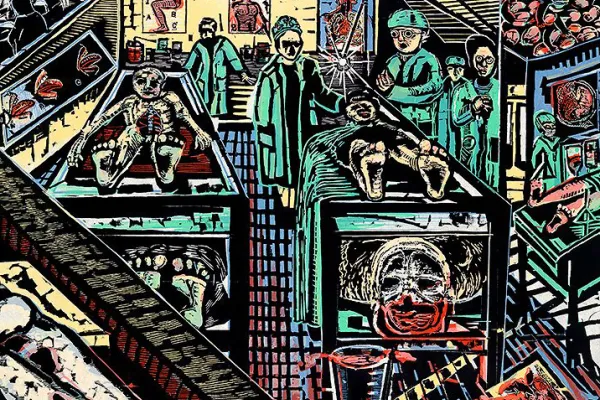Bearing Witness: Exhibition at SCMA Documents the AIDS Epidemic
Smith Arts

Published August 10, 2016
A new exhibition of prints and books about the AIDS epidemic opens Friday, Aug. 12, at the Smith College Museum of Art (SCMA).
Eric Avery: AIDS WORK features works by an artist, physician and gay activist who was at the center of the AIDS crisis, both personally and professionally. The show includes more than 30 of Avery’s prints and books that were acquired in 2014 by SCMA and Smith’s Mortimer Rare Book Room.
The exhibition will remain on view through December 11. The museum is offering related programs in the fall. Details are available on the museum’s website.
Aprile Gallant, organizing curator of the new exhibition and curator of prints, drawings and photographs at SCMA, says the exhibition offers “a cohesive and important body of work that documents three decades in the life of a major public health crisis through the eyes of an artist capable of seeing, understanding and translating the issue from multiple perspectives.”
If one person, after seeing one of my art actions, were motivated to change an HIV risk behavior and did not get HIV, then this would be my evidence that art can save lives.
The desire to provide information to the public and to enact positive change in the world is central to Dr. Avery’s view of his purpose as an artist.
“If you believe that information can lead to change, then bearing witness is the narrative function of art and serves a social purpose,” Avery told Gallant while they were planning the exhibition. “If one person, after seeing one of my art actions, were motivated to change an HIV risk behavior and did not get HIV, then this would be my evidence that art can save lives.”
Avery was born in 1948 in Milwaukee, Wis., and raised in Pecos, Texas. He received his bachelor’s degree in art from the University of Arizona in 1970, and earned a medical degree from the University of Texas Medical Branch at Galveston in 1974. Avery completed his residency in psychiatry at the New York State Psychiatric Institute in 1979.
That same year, Avery began working as a physician for World Vision in Indonesia, followed by a stint in Somalia from 1980 to 1981. While serving as medical director of the Las Dhure Refugee Camp in Somalia, he began to make woodcuts that drew directly on his experience with disease and issues of public health.
In 1981—the year the first case of AIDS in the United States was recognized and reported to the federal Centers for Disease Control—Avery returned to America. Over the next three years, the number of AIDS cases and deaths rose precipitously—particularly in the gay community.
Setting aside his medical practice, Avery volunteered as a refugee coordinator for Amnesty International and began to create artwork centered on the experiences of refugees at the Mexico/Texas border.
In 1992, as his friends began to die of AIDS, Avery returned to medicine, joining the psychiatry department and the Institute for Medical Humanities at the University of Texas Medical Branch (UTMB) at Galveston—a position from which he retired in 2012.
At the medical branch, Avery worked primarily with AIDS patients in UTMB clinics and in the prison system and became an expert in caring for transgendered people with HIV. Throughout this period, he also created art projects that focused on AIDS and broader issues of public health.
Eric Avery AIDS WORK at SCMA is supported by the Louise Walker Blaney, Smith Class of 1939, Fund for Exhibitions and the Carlyn Steiner ’67 and George Steiner Endowed Fund, in honor of Joan Smith Koch.
Eric Avery, American, born 1948. As It Is, from Damn It Suite, 1987 Woodcut printed in color on handmade Mulberry paper. Purchased. Permanent collection SCMA.